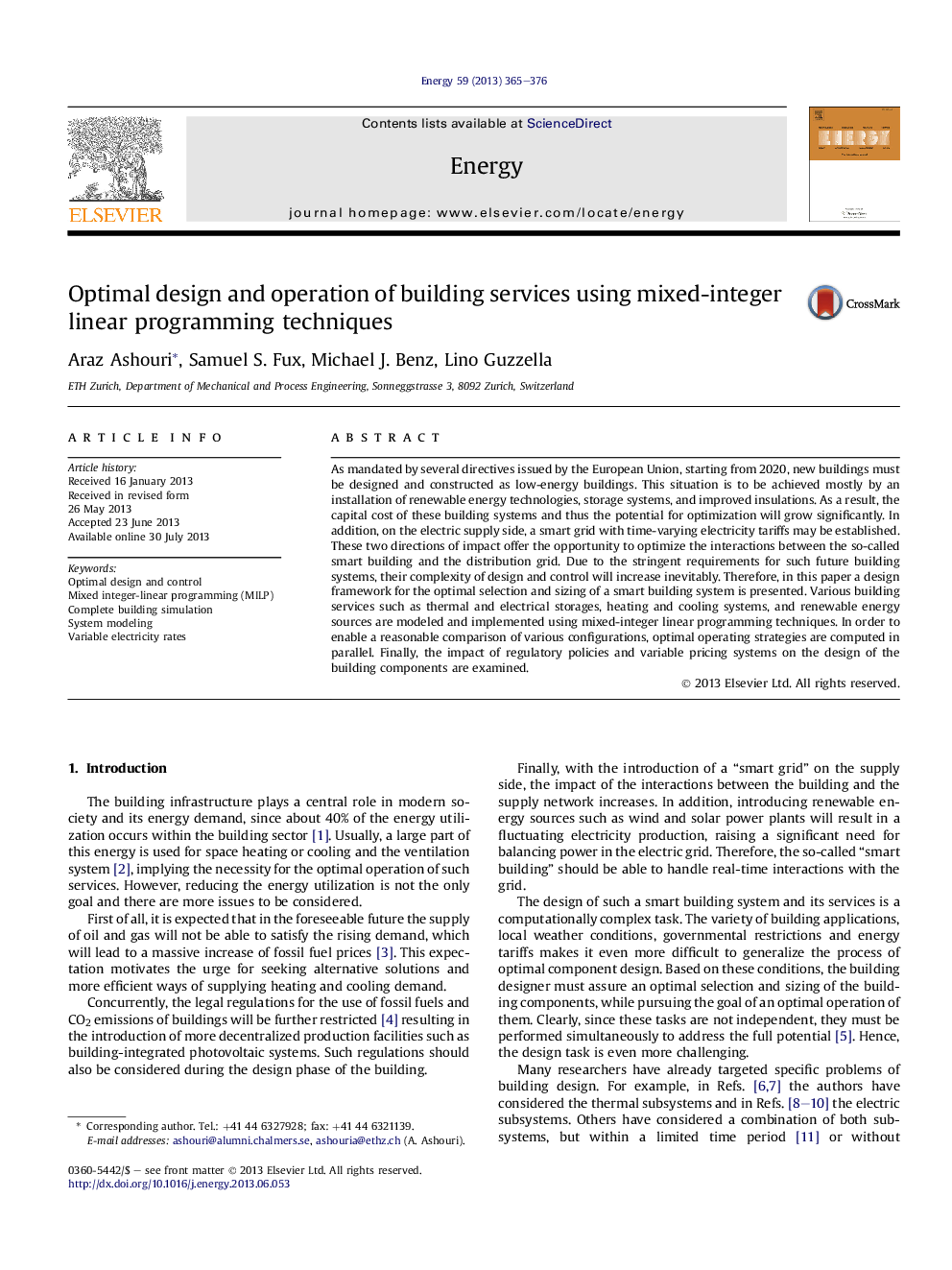| کد مقاله | کد نشریه | سال انتشار | مقاله انگلیسی | نسخه تمام متن |
|---|---|---|---|---|
| 8079215 | 1521487 | 2013 | 12 صفحه PDF | دانلود رایگان |
عنوان انگلیسی مقاله ISI
Optimal design and operation of building services using mixed-integer linear programming techniques
ترجمه فارسی عنوان
طراحی و اجرای مطلوب خدمات ساختمانی با استفاده از تکنیک های برنامه نویسی خطی تلفیقی عددی
دانلود مقاله + سفارش ترجمه
دانلود مقاله ISI انگلیسی
رایگان برای ایرانیان
ترجمه چکیده
همانطور که توسط چندین دستورالعمل توسط اتحادیه اروپا صادر شده است، از سال 2020، ساختمانهای جدید باید به عنوان ساختمانهای کم انرژی طراحی و ساخته شوند. این وضعیت عمدتا به وسیله نصب فن آوری های انرژی تجدید پذیر، سیستم های ذخیره سازی و بهبود عایق ها به دست می آید. به عنوان یک نتیجه، هزینه سرمایه این سیستم های ساختمان و در نتیجه بالقوه برای بهینه سازی به طور قابل توجهی رشد خواهد کرد. علاوه بر این، در بخش عرضه برق، یک شبکه هوشمند با تعرفه های مختلف برق تنظیم می شود. این دو جهت تاثیر، فرصتی را برای بهینه سازی تعاملات بین ساختمان هوشمند و شبکه توزیع ارائه می دهند. با توجه به الزامات سختگیرانه برای چنین سیستم های ساختمان آینده، پیچیدگی آنها از طراحی و کنترل ناگزیر افزایش خواهد یافت. بنابراین، در این مقاله یک چارچوب طراحی برای انتخاب بهینه و اندازه گیری یک سیستم ساختمان هوشمند ارائه شده است. خدمات مختلف ساختمان مانند ذخیره های حرارتی و الکتریکی، سیستم های گرمایشی و خنک کننده و منابع انرژی تجدید پذیر مدل سازی شده و با استفاده از تکنیک های برنامه ریزی خطی ترکیبی عدد صحیح اجرا می شود. به منظور ایجاد یک مقایسه مناسب از پیکربندی های مختلف، استراتژی های عملیاتی بهینه موازی محاسبه می شود. در نهایت، تاثیر سیاست های نظارتی و سیستم های قیمت گذاری متغیر در طراحی اجزای ساختمان بررسی می شود.
موضوعات مرتبط
مهندسی و علوم پایه
مهندسی انرژی
انرژی (عمومی)
چکیده انگلیسی
As mandated by several directives issued by the European Union, starting from 2020, new buildings must be designed and constructed as low-energy buildings. This situation is to be achieved mostly by an installation of renewable energy technologies, storage systems, and improved insulations. As a result, the capital cost of these building systems and thus the potential for optimization will grow significantly. In addition, on the electric supply side, a smart grid with time-varying electricity tariffs may be established. These two directions of impact offer the opportunity to optimize the interactions between the so-called smart building and the distribution grid. Due to the stringent requirements for such future building systems, their complexity of design and control will increase inevitably. Therefore, in this paper a design framework for the optimal selection and sizing of a smart building system is presented. Various building services such as thermal and electrical storages, heating and cooling systems, and renewable energy sources are modeled and implemented using mixed-integer linear programming techniques. In order to enable a reasonable comparison of various configurations, optimal operating strategies are computed in parallel. Finally, the impact of regulatory policies and variable pricing systems on the design of the building components are examined.
ناشر
Database: Elsevier - ScienceDirect (ساینس دایرکت)
Journal: Energy - Volume 59, 15 September 2013, Pages 365-376
Journal: Energy - Volume 59, 15 September 2013, Pages 365-376
نویسندگان
Araz Ashouri, Samuel S. Fux, Michael J. Benz, Lino Guzzella,
